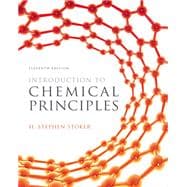Newly updated based on extensive reviewer feedback, this affordable introductory text remains focused on the essentials necessary for success in General Chemistry. Introduction to Chemistry Principles, Eleventh Edition focuses on the most important topics — omitting organic and biochemistry chapters — and teaches the problem-solving skills readers need. Each topic is introduced and developed step by step until reaching the level of sophistication required for further course work.
Note: There is no difference in content between the version with the plain cover and the version with the white and orange cover.








